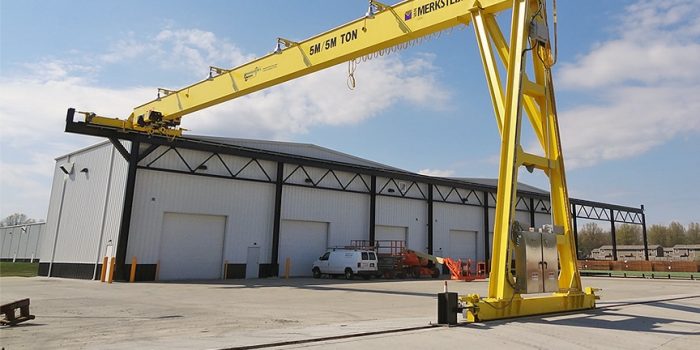A gantry crane is a load-handling device that supports itself. These overhead cranes can be single or double girder configurations and can be found in many models. On the crane’s free-standing legs there are wheels or other tracks that allow it to walk.
Unlike other cranes, gantry cranes do not require permanent support columns, according to gantry crane manufacturers. One of the most important benefits of gantry cranes is that they make processes easier and reduce costs. There are many different types and designs of gantry cranes. The following four gantry crane types are commonly used;
Full gantry crane system.
The most popular configuration of gantry cranes is those that have two legs attached to rails that rest flush with the top of the floor. In a dedicated work area, these machines usually follow a straight line. Motorized equipment such as scissor lifts, forklifts, carts, and trucks can pass under the crane in this way.
Semi-Gantry Crane Systems.
There are also gantry cranes that can be designed to ride on wheels or rails with one leg and the opposite leg riding on a runway system connected to the columns or the sidewalls of a building. It saves you a lot of floor space and you have more room for work. It does not require two runways that are tied to or supported by building columns like a bridge crane.
Portable Gantry Crane Systems.
The portable gantry crane is a lighter-weight gantry system that runs on rubber wheels or casters. The user can move it around a facility in order to move various materials or loads. Since they can be moved around a shop, into different work cells, and stored anywhere they are not loaded, they offer greater flexibility and space savings.
What are they used for?
Heavy fabrication applications use full or semi-gantry cranes, as well as yard and shipping applications.
For areas where slab concrete is formed and cured, they’re also very popular for cement and precast applications. Due to their design, they are suitable for use both indoors and outdoors and also allow forklift trucks to work and travel underneath.
Mobile gantry cranes are typically used to lift, hold, and work on production equipment. Gantries themselves are not necessarily moving the load but can be moved around to work on various parts and equipment.
As well as offering more flexibility than a jib crane and workstation crane, gantry systems can move from one location to another. In most cases, a jib crane has to be installed on a poured concrete foundation, and they tend to remain permanently in place once they’re installed.
As your business grows and you find the best way to optimize and layout space within your warehouse, a portable gantry crane can perform the same functions as a larger jib crane.
Gantry systems that run on rails or tracks embedded in the ground are much larger and are used in specific work areas. Another advantage of gantry cranes is their portability.
Whether you are building or working in an industrial setting, these installations can readily move around your facility and adhere to light fabrication and maintenance tasks.


